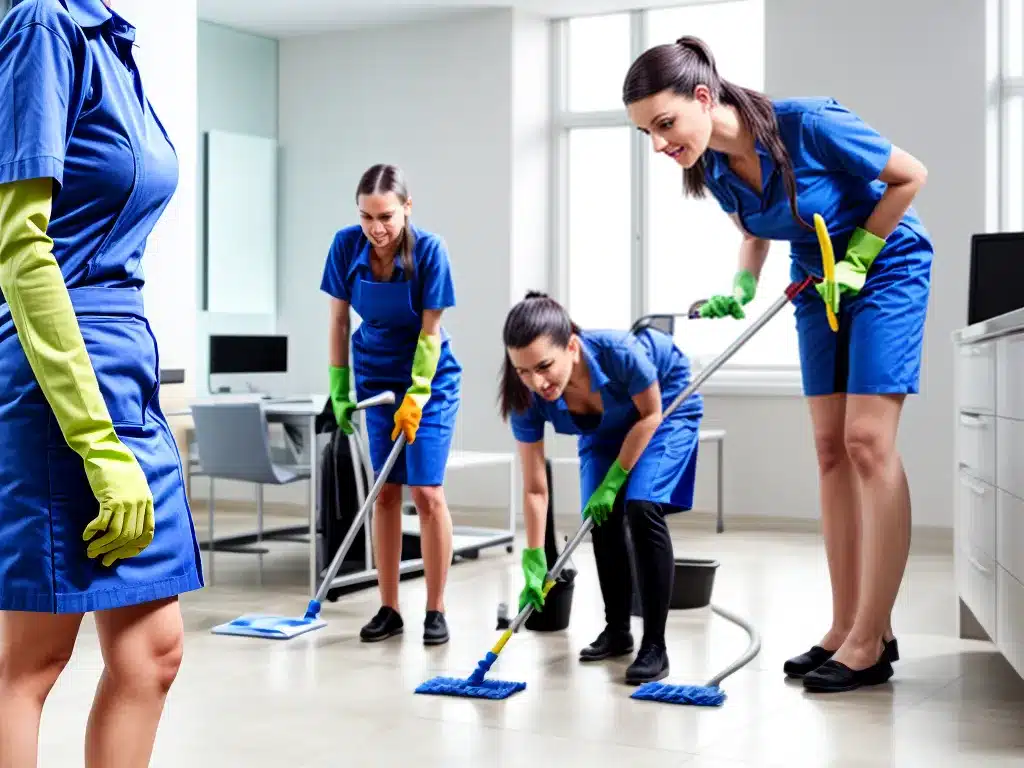Introduction
As a cleaning business owner, I know that investing in ongoing training for my staff is one of the most important things I can do to ensure my business succeeds. Proper training helps cleaning professionals develop their skills, learn best practices, and provide better service. In this article, I’ll explore the benefits of ongoing training and provide actionable tips for business owners looking to implement a training program.
Why Ongoing Training Matters
Providing initial training when hiring new staff is important, but ongoing training throughout their tenure is key to seeing real improvements. Here are some of the main benefits of investing in regular training:
Improves Skills and Techniques
With regular training sessions, cleaners can expand their knowledge of proper cleaning techniques for various surfaces and spaces. For example, training on sanitizing methods, chemical use, and equipment operation helps them tackle different cleaning challenges.
Increases Productivity
Well-trained staff who sharpen their skills over time work faster and more efficiently. Productivity training focuses on time management, organization, and process optimization. This allows cleaners to get more done in less time.
Reduces Safety Incidents
Safety training is crucial for identifying and mitigating risks in cleaning work. It covers topics like chemical handling, ergonomics, and preventing slips and falls. Ongoing training reinforces safety best practices and helps prevent accidents.
Provides Better Customer Service
Training on communication, problem-solving, and exceeding expectations helps staff deliver exceptional service. This improves customer satisfaction, retention, and referral rates.
Boosts Employee Satisfaction
Investing time and resources in training makes employees feel valued and gives them a sense of purpose. This improves engagement, morale, and retention.
Developing an Ongoing Training Program
Implementing regular, meaningful training requires planning and commitment. Here is a step-by-step process:
Assess Needs
Analyze gaps in staff skills, knowledge, and capabilities. Ask employees for input on areas they want more training. Review customer complaints to identify recurring issues that training could address.
Set Goals
Define specific training objectives based on needs – e.g. reduce safety incidents by 15%, or increase customer satisfaction scores by 20%. Tie goals to business KPIs so you can measure ROI.
Create a Curriculum
Develop a training calendar that covers key topics on a quarterly or annual basis. Include a mix of skills training, safety, customer service, etc.
Deliver Training
Conduct training during staff meetings or schedule dedicated sessions. Mix lectures, hands-on activities, videos, quizzes, and discussions.
Measure and Optimize
Track training effectiveness by comparing metrics before and after – e.g. compliance, productivity, retention. Get feedback from staff and tweak the program as needed.
Training Topics to Consider
Here are some example training topics to incorporate into an ongoing program:
Cleaning Skills
- Proper techniques for floors, carpets, bathrooms, kitchens, windows, furniture, etc.
- Using and maintaining equipment like vacuums, mops, steamers, etc.
- Proper usage of cleaning agents and disinfectants
- Supply management and restocking processes
Safety
- Hazard identification and risk reduction
- Proper use of PPE and safe lifting procedures
- Chemical safety – SDS, dilution, storage, disposal
- Preventing slips/trips/falls and repetitive strain injuries
Customer Service
- Communication etiquette and problem-solving
- Exceeding expectations and delivering “wow” factor
- Managing relationships with clients and tenants
Work Habits
- Time management, planning, and organization
- Developing efficient routines and checklists
- Managing workload and reducing fatigue/burnout
Company Policies
- Review handbook, ethics, dress code, attendance, etc.
- New protocols and guidelines
Making Training Engaging
For training to be effective, employees need to be engaged and excited to learn. Here are some tips:
-
Incorporate interactive elements like hands-on demonstrations, games, group discussions, and activities. This stimulates engagement more than just lecturing alone.
-
Use a variety of formats including videos, slide presentations, written materials, and visual aids. Different learning styles are engaged through multimedia approaches.
-
Share success stories of how past training improved employee performance or service delivery. This reinforces why the training matters.
-
Make it fun and celebrate wins with contests, incentives, certificates, shoutouts, and food. A positive atmosphere helps employees retain information.
-
Get employee feedback and ask for training topic suggestions. Employees are more engaged when they have input into their development.
Conclusion
Implementing ongoing training requires an investment of time and money. But the long-term benefits for your staff, customers, and bottom line make it well worth the effort. With a structured training program, employees build skills progressively and stay motivated. This leads to better performance, productivity, retention and business growth. By demonstrating your commitment to developing your team, they’ll be committed to delivering ever-higher quality and value in their cleaning services.







